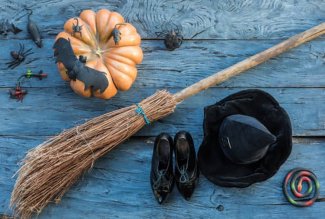
Successful alewives from the Middle Ages, who used funnels with top vents (which today’s costume witch hats resemble) and cauldrons to make their product, were sometimes accused of witchcraft by less profitable male brewers as an underhanded attempt to vie for customers. Today, witchcraft accusations still abound—take the American political arena, where freshman female Congresswoman Alexandria Ocasio-Cortez has been accused by some conservatives of leading a coven and former president Donald Trump has, hundreds of times, characterized criminal and civil investigations of him as “witch hunts.”
Halloween 2021 will soon be observed but, regardless of the season, witchcraft is a perennially intriguing topic that has fueled creativity. That’s partly why Jennifer Pullen, Ph.D., an assistant professor of creative writing and fiction at Ohio Northern University, will be teaching a new Topics in Fiction course in spring 2022 on witches in literature and film. Pullen intends for her students to analyze and interrogate how and why witches have been represented over the years in words and cinema, specifically through historical and fantasy fiction works. Power dynamics, patriarchal positioning, gender, class and more will be addressed.
A self-described “giant nerd” who has taught several courses focusing on fairy tales, Pullen says she is interested in the dichotomy between witchcraft as a female empowerment vehicle and its maligned status as that of pure evil. The commercialization and rhetorical nuances of how witchcraft is portrayed are also on her radar.
“It’s social and it’s economic, which we see over and over again. There’s just a lot to it. I’m interested in the tension between thinking about witches as an idea that’s powerful and positive versus being used negative as a disciplinary function against people who speak out,” she says.
Pullen notes the case of medicine’s emergence as a professionalized field years ago, in which some men intent on commodifying and regulating the practice tended to impugn women who had already established themselves as herbal healers, midwives and other trusted medical practitioners within their communities.
She also mentioned pop cultural instances in which witches are domesticated, their demeanor and power over others restrained, and their lives focused on servitude. The classic TV series “Bewitched” is an example of this archetype.
Pullen says in some historical literary instances, characters who were originally depicted as fairies and goddesses altered over time into witches with more nefarious intentions.
The spring course will be “looking at witches in terms of historical fiction, their actual history, and our contemporary cultural interactions with the idea of witchcraft,” Pullen says.
Some of the reading material will include “I, Tituba, Black Witch of Salem,” a novel written from the point of view of a real-life West Indian slave who was charged with witchcraft during the Salem witch trails; “Witch Light,” a novel set in the Scottish Highlands around the time of the Massacre of Glencoe, that focuses on the conversations and memories of the female protagonist; and “Like Water for Chocolate,” a Latin American magical realism book with a cooking-centered theme. Students will also watch the 2000 comedy-drama film “Chocolat,” a scene from “Wicked,” “Kiki’s Delivery Service,” and other relevant film selections.
Additionally, as with many of her other courses, Pullen intends to incorporate a creative writing element into this curriculum. “I like to give students a chance to engage with the arts through creating something, which I think is more fun than just writing a regular paper,” she says.
“I think the students are excited” about this course, Pullen says. In some of the courses she taught this past spring semester, she had suggested two options for an upcoming topics course. “They overwhelmingly said, ‘We want witches,’” she maintains.